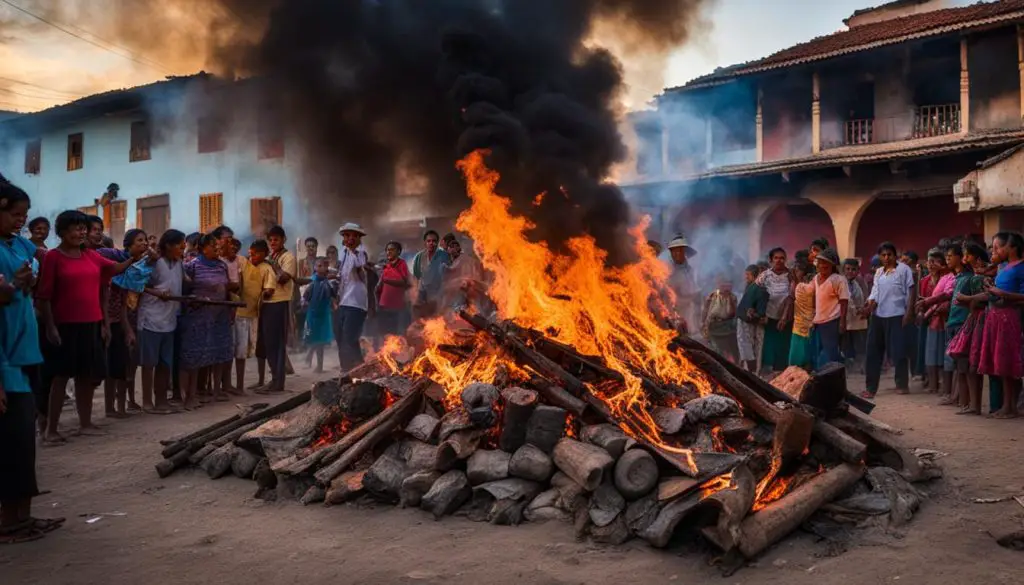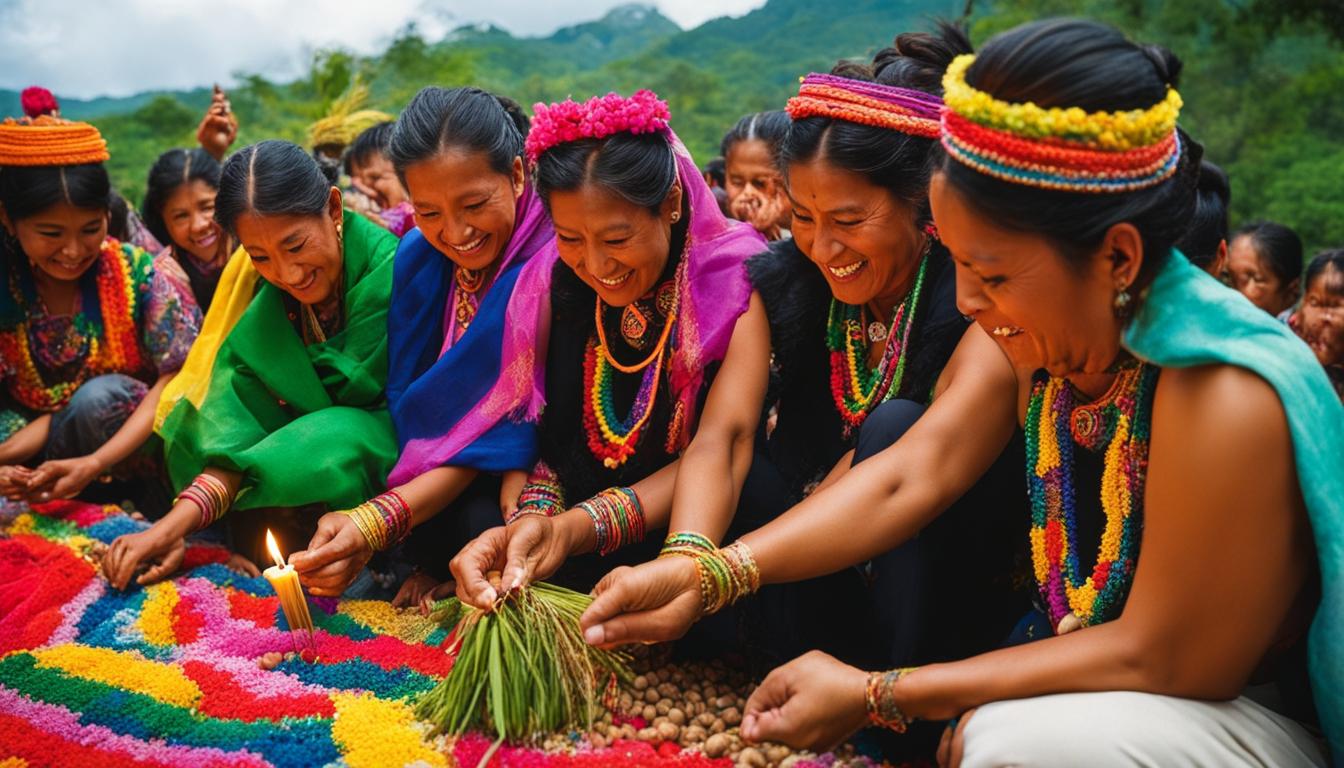Central America has a rich tradition of customs and beliefs surrounding good luck. From eating specific foods to performing certain rituals, the people of Central America have various practices to bring fortune into their lives. Let’s delve into the fascinating traditions and symbolic items that are given for good luck in Central America.
Contents
- 1 Eating Grapes for Good Fortune
- 2 Wearing Specific Colors for Luck
- 3 Table: Color Symbolism in Central America
- 4 Cleaning and Decluttering for a Fresh Start
- 5 Conclusion
- 6 FAQ
- 6.1 What are some traditions for good luck in Central America?
- 6.2 Why do people eat grapes on New Year’s Eve in Central America?
- 6.3 What colors are considered lucky in Central America?
- 6.4 Why do people clean their houses for the new year in Central America?
- 6.5 What is the belief behind placing money in shoes for prosperity in Central America?
- 6.6 Why do people burn symbolic dolls in Central America?
- 7 Source Links
Key Takeaways:
- Central America has a diverse range of cultural beliefs and traditions related to good luck.
- Eating grapes on New Year’s Eve is believed to bring good fortune throughout the year.
- Wearing specific colors, such as yellow or white, is thought to attract luck and prosperity.
- Cleaning and decluttering the house is a common practice to start the new year fresh.
- Placing money in shoes or carrying gold coins is believed to bring financial abundance.
Eating Grapes for Good Fortune
In many Latin American countries, including Central America, it is a common tradition to eat 12 grapes at the stroke of midnight on New Year’s Eve. Each grape represents a month of the year, and by consuming them, individuals believe that they will ensure good fortune throughout the coming year. This tradition is believed to have originated in Spain and has now spread to various parts of Central America.
This practice of eating grapes for good luck is deeply rooted in the belief that grapes symbolize abundance and prosperity. It is believed that by consuming the grapes, you are inviting positive energy and blessings into your life. This ritual has become an important part of New Year’s celebrations in Central America, where families and friends gather to welcome the new year together.
As the clock strikes midnight, people eagerly pop the grapes into their mouths, making a wish with each one. It is said that if you can finish eating all 12 grapes before the last stroke of midnight, your wishes will come true. This tradition not only adds a fun and festive element to New Year’s Eve but also serves as a reminder to be grateful for the blessings of the past year and to look forward to a prosperous future.
The Symbolic Meaning of Lucky Grapes
“Eating the twelve grapes to welcome the new year is like planting twelve seeds of good fortune. It’s a moment of hope and optimism for what lies ahead. By consuming the grapes, we are reaffirming our belief in abundance, prosperity, and good luck.”
In addition to the belief in the symbolic meaning of grapes, this tradition also brings people together, strengthening the bonds of family and community. It is a time to reflect on the past and make wishes for the future, creating a sense of unity and shared hope among the participants. So, when you gather with your loved ones this New Year’s Eve, don’t forget to have your grapes ready and embrace this beautiful tradition of eating grapes for good fortune!
Table: Central American New Year’s Traditions
| New Year’s Tradition | Country |
|---|---|
| Eating 12 grapes at midnight | Mexico, El Salvador, Guatemala, Honduras, Nicaragua, Costa Rica, Panama |
| Burning “el año viejo” doll | Ecuador |
| Wearing yellow underwear | Venezuela, Colombia, Ecuador |
| Jumping seven waves | Brazil |
| Placing money in shoes | Peru, Bolivia |
Wearing Specific Colors for Luck
In Central America, the power of color symbolism is deeply ingrained in cultural beliefs, particularly when it comes to attracting good luck. People in this region embrace the practice of wearing specific colors to invite positive energy and enhance their fortunes.
One prominent example is the tradition of wearing head-to-toe white in Brazil during New Year’s celebrations. This practice is accompanied by jumping seven waves or placing flowers in the ocean, all with the intention of bringing luck for the coming year. Similarly, across Latin America, individuals don yellow, white, or red underwear as a way to invite good fortune. Red is associated with enhancing the love life, while yellow is believed to bring overall prosperity.
Interestingly, there is a general avoidance of the color black in Central America, as it is commonly associated with bad luck. This perception aligns with the belief that walking under a ladder brings negative consequences. By consciously selecting and incorporating specific colors into their attire, people in Central America actively seek to manifest positive outcomes in their lives.
Color Symbolism in Central America
The choice of colors for good luck in Central America is deeply rooted in cultural symbolism. Each color represents different aspects of fortune and blessings. Here are some examples of lucky colors and their significance:
- Yellow: Associated with abundance, wealth, and a prosperous future.
- White: Symbolizes purity, clarity, and new beginnings.
- Red: Signifies passion, love, and a vibrant love life.
While these are just a few examples, the practice of wearing specific colors for luck demonstrates the importance of symbolism and intention in Central American culture.
Table: Color Symbolism in Central America
| Color | Symbolism |
|---|---|
| Yellow | Abundance, wealth, prosperity |
| White | Purity, clarity, new beginnings |
| Red | Passion, love, vibrant love life |
By embracing the practice of wearing specific colors for luck, people in Central America continue to preserve and celebrate their cultural traditions, infusing their lives with symbolism and hope for a brighter future.
Cleaning and Decluttering for a Fresh Start
If you’re looking to start the new year on a positive note, one tradition in Central America that you might consider is engaging in a thorough cleaning of your house. It’s believed that this practice helps get rid of any bad vibes or negative energy that may have accumulated over the past year, making room for fresh and positive energy to flow into your life.
Cleaning not only physically transforms your living space but also has a psychological impact. As you declutter and organize your surroundings, you create a sense of order and harmony. This can have a profound effect on your mindset, helping you let go of the past and embrace the new possibilities that the coming year holds.
As you clean, think of it as a symbolic act of preparing yourself for a fresh start. Take the opportunity to reflect on the things that no longer serve you and let go of any emotional baggage. By creating a clean and welcoming environment, you’re setting the stage for positive experiences and new beginnings in the year ahead.

Conclusion
In conclusion, Central America is a region rich in cultural traditions and beliefs surrounding good luck. The people of Central America have a deep-rooted desire for positivity and prosperity in the new year, which is reflected in their customs and practices.
From the tradition of eating grapes for good fortune on New Year’s Eve to the belief in wearing specific colors for luck, Central Americans have unique ways of attracting good luck into their lives. Cleaning and decluttering the house at the start of the year is seen as a way to get rid of negative energy and make room for positive vibes and new opportunities.
The superstition of placing money in shoes or carrying gold coins during New Year’s celebrations is believed to bring financial abundance and ensure a prosperous year ahead. And the symbolic act of burning the old year, represented by a straw doll, is a powerful practice of letting go of negative energy and embracing new beginnings.
These traditions not only bring communities together but also provide individuals with a sense of hope and belief in a better future. Whether it’s through grapes, colors, or symbolic acts, the people of Central America embrace these traditions to invite good luck into their lives and start the new year on a positive note.
FAQ
What are some traditions for good luck in Central America?
Central America has various traditions for good luck, including eating grapes at midnight on New Year’s Eve, wearing specific colors, cleaning houses, placing money in shoes, and burning symbolic dolls.
Why do people eat grapes on New Year’s Eve in Central America?
Eating 12 grapes at the stroke of midnight is believed to bring good fortune throughout the coming year. Each grape represents a month of the year.
What colors are considered lucky in Central America?
Yellow, white, and red are considered lucky colors in Central America. Yellow symbolizes overall good fortune, red enhances love life, and white is associated with prosperity.
Why do people clean their houses for the new year in Central America?
Cleaning houses is believed to get rid of any bad energy from the previous year and make room for positive energy and opportunities in the coming year.
What is the belief behind placing money in shoes for prosperity in Central America?
Placing money in shoes is believed to attract financial abundance and ensure a prosperous new year. Some variations suggest carrying a red coin holder with 13 gold coins during New Year’s Eve dinner.
Why do people burn symbolic dolls in Central America?
Burning symbolic dolls, known as “el año viejo,” is a way of letting go of negative energy and starting fresh in the new year. It represents the end of the past and the beginning of a new chapter.






